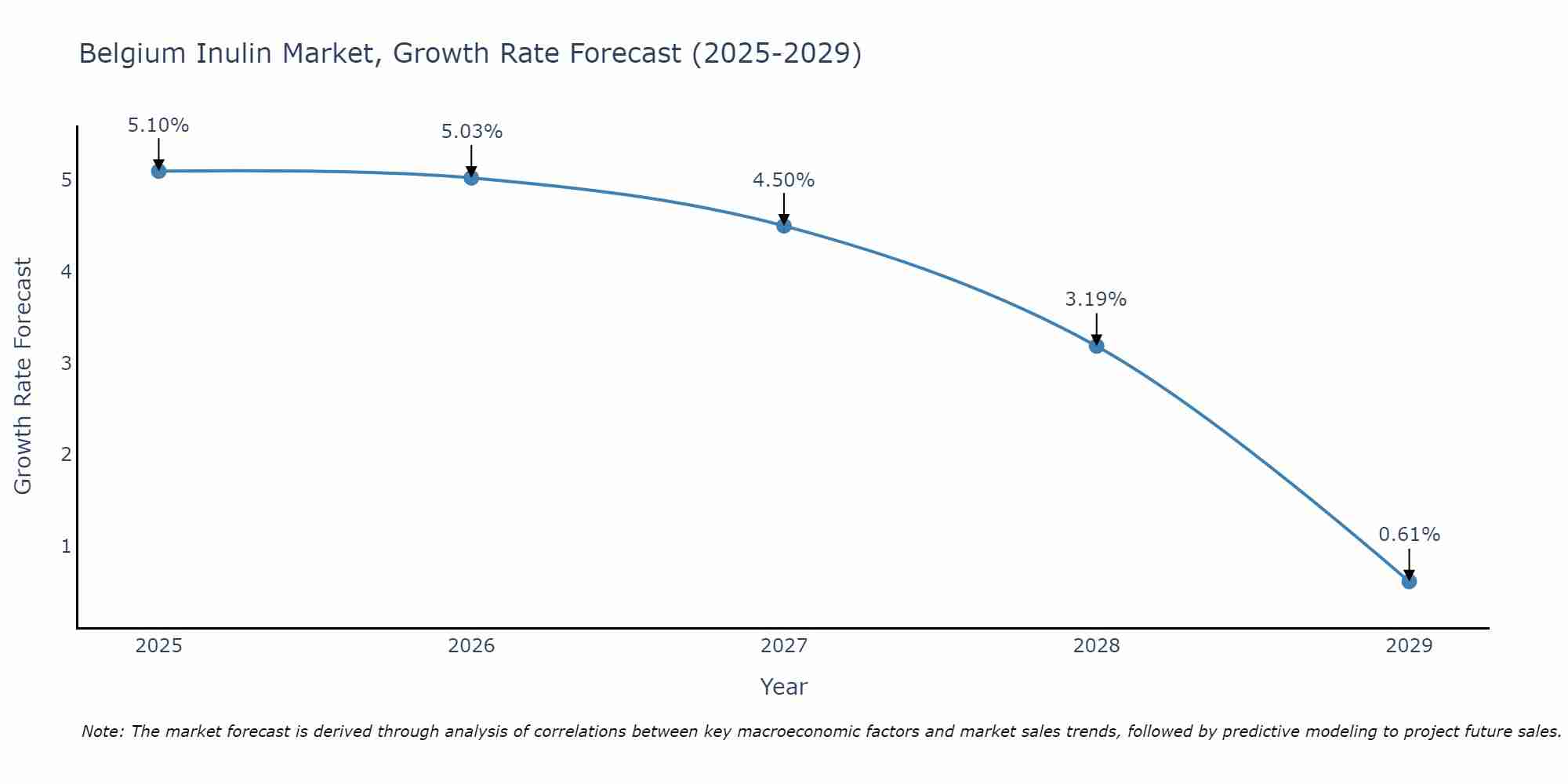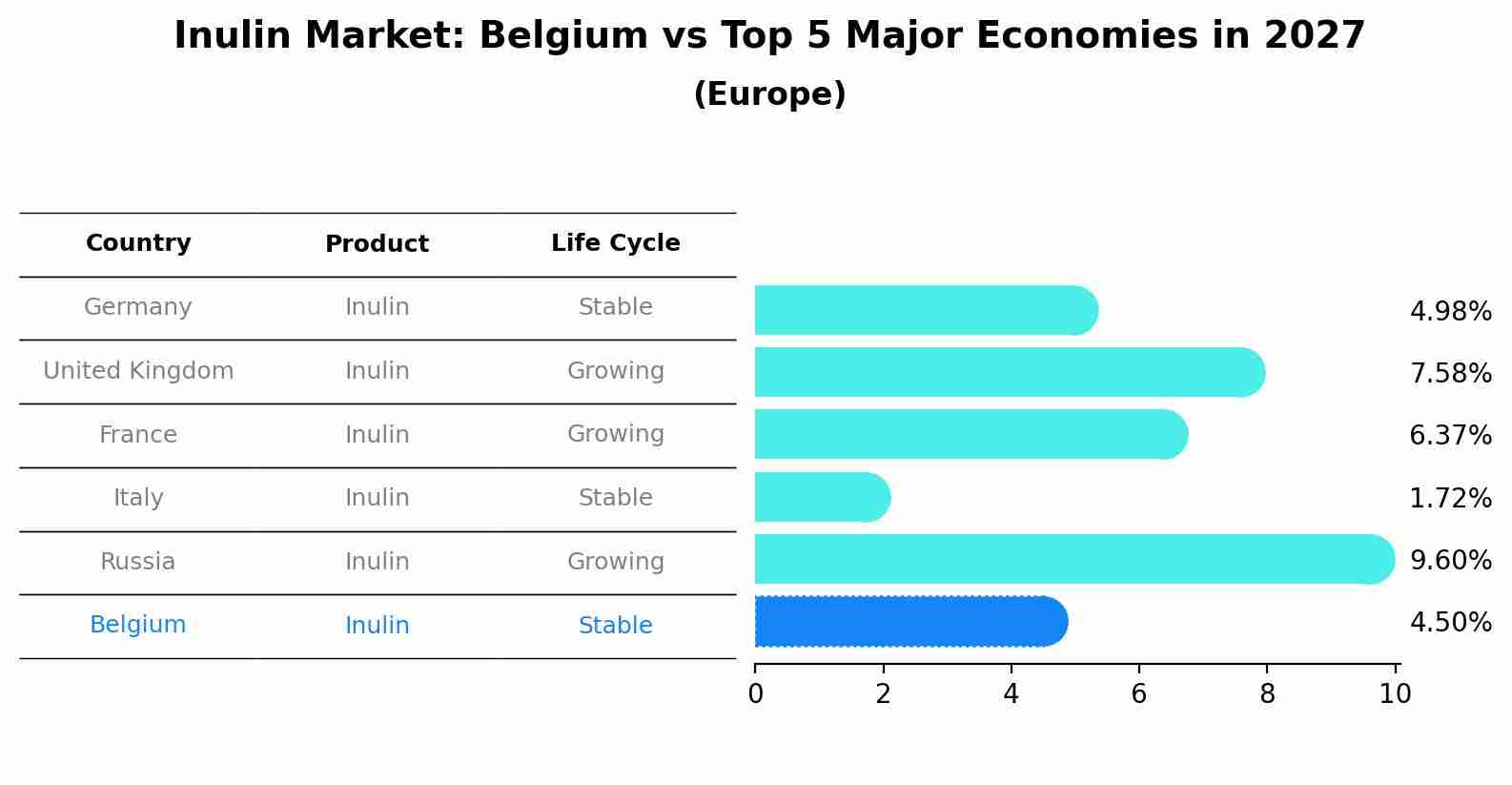Belgium Inulin Market (2025-2031) | Revenue, Trends, Share, Value, Growth, Forecast, Outlook, Segmentation, Analysis, Companies, Size & Industry
| Product Code: ETC4846390 | Publication Date: Nov 2023 | Updated Date: Sep 2025 | Product Type: Market Research Report | |
| Publisher: 6Wresearch | Author: Sachin Kumar Rai | No. of Pages: 60 | No. of Figures: 30 | No. of Tables: 5 |
Belgium Inulin Market Size Growth Rate
The Belgium Inulin Market could see a tapering of growth rates over 2025 to 2029. Although the growth rate starts strong at 5.10% in 2025, it steadily loses momentum, ending at 0.61% by 2029.

Inulin Market: Belgium vs Top 5 Major Economies in 2027 (Europe)
In the Europe region, the Inulin market in Belgium is projected to expand at a stable growth rate of 4.50% by 2027. The largest economy is Germany, followed by United Kingdom, France, Italy and Russia.

Belgium Inulin Market Overview
The Belgium inulin market benefits from the rising consumer demand for functional foods and dietary supplements. Inulin, a type of prebiotic fiber found in various fruits and vegetables, is popular for its health benefits, including improved digestive health and blood sugar regulation. The market is bolstered by growing health-consciousness among consumers and increasing use of inulin in food and beverage products as a sugar substitute and fiber enhancer.
Drivers of the market
The Belgium inulin market benefits from the rising demand for dietary fiber and the growing trend towards healthier eating. Inulin, a prebiotic fiber, is increasingly used in food and beverage products to enhance nutritional value and improve gut health. Additionally, the awareness of inulin`s benefits for blood sugar management and digestive health drives its adoption in various applications.
Challenges of the market
The Belgium inulin market is challenged by fluctuating raw material prices, which can impact the cost and availability of inulin. Additionally, there is competition from alternative dietary fibers, which can affect market demand. Regulatory requirements and the need for consistent quality and safety standards further complicate market dynamics.
Government Policy of the market
The inulin market in Belgium is subject to EU regulations on food additives and ingredients, particularly the European Food Safety Authority (EFSA) guidelines. Inulin, as a dietary fiber, is regulated under food safety laws that ensure it is safe for consumption and accurately labeled. The Federal Public Service (FPS) Health, Food Chain Safety, and Environment oversees these regulations, ensuring that inulin used in food products meets health and safety standards.
Key Highlights of the Report:
- Belgium Inulin Market Outlook
- Market Size of Belgium Inulin Market, 2024
- Forecast of Belgium Inulin Market, 2031
- Historical Data and Forecast of Belgium Inulin Revenues & Volume for the Period 2021-2031
- Belgium Inulin Market Trend Evolution
- Belgium Inulin Market Drivers and Challenges
- Belgium Inulin Price Trends
- Belgium Inulin Porter`s Five Forces
- Belgium Inulin Industry Life Cycle
- Historical Data and Forecast of Belgium Inulin Market Revenues & Volume By Form for the Period 2021-2031
- Historical Data and Forecast of Belgium Inulin Market Revenues & Volume By Powder for the Period 2021-2031
- Historical Data and Forecast of Belgium Inulin Market Revenues & Volume By Liquid for the Period 2021-2031
- Historical Data and Forecast of Belgium Inulin Market Revenues & Volume By Nature for the Period 2021-2031
- Historical Data and Forecast of Belgium Inulin Market Revenues & Volume By Organic for the Period 2021-2031
- Historical Data and Forecast of Belgium Inulin Market Revenues & Volume By Conventional for the Period 2021-2031
- Historical Data and Forecast of Belgium Inulin Market Revenues & Volume By Source for the Period 2021-2031
- Historical Data and Forecast of Belgium Inulin Market Revenues & Volume By Agave for the Period 2021-2031
- Historical Data and Forecast of Belgium Inulin Market Revenues & Volume By Chicory for the Period 2021-2031
- Historical Data and Forecast of Belgium Inulin Market Revenues & Volume By Jerusalem Artichoke for the Period 2021-2031
- Historical Data and Forecast of Belgium Inulin Market Revenues & Volume By Others for the Period 2021-2031
- Historical Data and Forecast of Belgium Inulin Market Revenues & Volume By Application for the Period 2021-2031
- Historical Data and Forecast of Belgium Inulin Market Revenues & Volume By Food & Beverages for the Period 2021-2031
- Historical Data and Forecast of Belgium Inulin Market Revenues & Volume By Dietary Supplements for the Period 2021-2031
- Historical Data and Forecast of Belgium Inulin Market Revenues & Volume By Pharmaceuticals for the Period 2021-2031
- Historical Data and Forecast of Belgium Inulin Market Revenues & Volume By Animal Feed for the Period 2021-2031
- Belgium Inulin Import Export Trade Statistics
- Market Opportunity Assessment By Form
- Market Opportunity Assessment By Nature
- Market Opportunity Assessment By Source
- Market Opportunity Assessment By Application
- Belgium Inulin Top Companies Market Share
- Belgium Inulin Competitive Benchmarking By Technical and Operational Parameters
- Belgium Inulin Company Profiles
- Belgium Inulin Key Strategic Recommendations
Frequently Asked Questions About the Market Study (FAQs):
1 Executive Summary |
2 Introduction |
2.1 Key Highlights of the Report |
2.2 Report Description |
2.3 Market Scope & Segmentation |
2.4 Research Methodology |
2.5 Assumptions |
3 Belgium Inulin Market Overview |
3.1 Belgium Country Macro Economic Indicators |
3.2 Belgium Inulin Market Revenues & Volume, 2021 & 2031F |
3.3 Belgium Inulin Market - Industry Life Cycle |
3.4 Belgium Inulin Market - Porter's Five Forces |
3.5 Belgium Inulin Market Revenues & Volume Share, By Form, 2021 & 2031F |
3.6 Belgium Inulin Market Revenues & Volume Share, By Nature, 2021 & 2031F |
3.7 Belgium Inulin Market Revenues & Volume Share, By Source, 2021 & 2031F |
3.8 Belgium Inulin Market Revenues & Volume Share, By Application, 2021 & 2031F |
4 Belgium Inulin Market Dynamics |
4.1 Impact Analysis |
4.2 Market Drivers |
4.2.1 Increasing consumer awareness about the health benefits of inulin |
4.2.2 Growing demand for natural and functional food ingredients |
4.2.3 Rise in prevalence of lifestyle diseases driving the demand for low-calorie sweeteners like inulin |
4.3 Market Restraints |
4.3.1 Fluctuating prices of raw materials impacting production costs |
4.3.2 Stringent regulations and quality standards in the food industry |
4.3.3 Limited availability of inulin sources leading to supply chain challenges |
5 Belgium Inulin Market Trends |
6 Belgium Inulin Market Segmentations |
6.1 Belgium Inulin Market, By Form |
6.1.1 Overview and Analysis |
6.1.2 Belgium Inulin Market Revenues & Volume, By Powder, 2021-2031F |
6.1.3 Belgium Inulin Market Revenues & Volume, By Liquid, 2021-2031F |
6.2 Belgium Inulin Market, By Nature |
6.2.1 Overview and Analysis |
6.2.2 Belgium Inulin Market Revenues & Volume, By Organic, 2021-2031F |
6.2.3 Belgium Inulin Market Revenues & Volume, By Conventional, 2021-2031F |
6.3 Belgium Inulin Market, By Source |
6.3.1 Overview and Analysis |
6.3.2 Belgium Inulin Market Revenues & Volume, By Agave, 2021-2031F |
6.3.3 Belgium Inulin Market Revenues & Volume, By Chicory, 2021-2031F |
6.3.4 Belgium Inulin Market Revenues & Volume, By Jerusalem Artichoke, 2021-2031F |
6.3.5 Belgium Inulin Market Revenues & Volume, By Others, 2021-2031F |
6.4 Belgium Inulin Market, By Application |
6.4.1 Overview and Analysis |
6.4.2 Belgium Inulin Market Revenues & Volume, By Food & Beverages, 2021-2031F |
6.4.3 Belgium Inulin Market Revenues & Volume, By Dietary Supplements, 2021-2031F |
6.4.4 Belgium Inulin Market Revenues & Volume, By Pharmaceuticals, 2021-2031F |
6.4.5 Belgium Inulin Market Revenues & Volume, By Animal Feed, 2021-2031F |
7 Belgium Inulin Market Import-Export Trade Statistics |
7.1 Belgium Inulin Market Export to Major Countries |
7.2 Belgium Inulin Market Imports from Major Countries |
8 Belgium Inulin Market Key Performance Indicators |
8.1 Research and development investment in inulin-based product innovation |
8.2 Consumer adoption rate of inulin-enriched products |
8.3 Number of partnerships and collaborations within the inulin market for product expansion |
9 Belgium Inulin Market - Opportunity Assessment |
9.1 Belgium Inulin Market Opportunity Assessment, By Form, 2021 & 2031F |
9.2 Belgium Inulin Market Opportunity Assessment, By Nature, 2021 & 2031F |
9.3 Belgium Inulin Market Opportunity Assessment, By Source, 2021 & 2031F |
9.4 Belgium Inulin Market Opportunity Assessment, By Application, 2021 & 2031F |
10 Belgium Inulin Market - Competitive Landscape |
10.1 Belgium Inulin Market Revenue Share, By Companies, 2024 |
10.2 Belgium Inulin Market Competitive Benchmarking, By Operating and Technical Parameters |
11 Company Profiles |
12 Recommendations | 13 Disclaimer |
- Single User License$ 1,995
- Department License$ 2,400
- Site License$ 3,120
- Global License$ 3,795
Search
Related Reports
- ASEAN Bearings Market (2025-2031) | Strategy, Consumer Insights, Analysis, Investment Trends, Opportunities, Growth, Size, Share, Industry, Revenue, Segments, Value, Segmentation, Supply, Forecast, Restraints, Outlook, Competition, Drivers, Trends, Demand, Pricing Analysis, Competitive, Strategic Insights, Companies, Challenges
- Europe Flooring Market (2025-2031) | Outlook, Share, Industry, Trends, Forecast, Companies, Revenue, Size, Analysis, Growth & Value
- Saudi Arabia Manlift Market (2025-2031) | Outlook, Size, Growth, Trends, Companies, Industry, Revenue, Value, Share, Forecast & Analysis
- Uganda Excavator, Crane, and Wheel Loaders Market (2025-2031) | Strategy, Consumer Insights, Analysis, Investment Trends, Opportunities, Growth, Size, Share, Industry, Revenue, Segments, Value, Segmentation, Supply, Forecast, Restraints, Outlook, Competition, Drivers, Trends, Demand, Pricing Analysis, Competitive, Strategic Insights, Companies, Challenges
- Rwanda Excavator, Crane, and Wheel Loaders Market (2025-2031) | Strategy, Consumer Insights, Analysis, Investment Trends, Opportunities, Growth, Size, Share, Industry, Revenue, Segments, Value, Segmentation, Supply, Forecast, Restraints, Outlook, Competition, Drivers, Trends, Demand, Pricing Analysis, Competitive, Strategic Insights, Companies, Challenges
- Kenya Excavator, Crane, and Wheel Loaders Market (2025-2031) | Strategy, Consumer Insights, Analysis, Investment Trends, Opportunities, Growth, Size, Share, Industry, Revenue, Segments, Value, Segmentation, Supply, Forecast, Restraints, Outlook, Competition, Drivers, Trends, Demand, Pricing Analysis, Competitive, Strategic Insights, Companies, Challenges
- Angola Excavator, Crane, and Wheel Loaders Market (2025-2031) | Strategy, Consumer Insights, Analysis, Investment Trends, Opportunities, Growth, Size, Share, Industry, Revenue, Segments, Value, Segmentation, Supply, Forecast, Restraints, Outlook, Competition, Drivers, Trends, Demand, Pricing Analysis, Competitive, Strategic Insights, Companies, Challenges
- Israel Intelligent Transport System Market (2025-2031) | Strategy, Consumer Insights, Analysis, Investment Trends, Opportunities, Growth, Size, Share, Industry, Revenue, Segments, Value, Segmentation, Supply, Forecast, Restraints, Outlook, Competition, Drivers, Trends, Demand, Pricing Analysis, Competitive, Strategic Insights, Companies, Challenges
- Uganda Precast and Aggregate Market (2025-2031) | Strategy, Consumer Insights, Analysis, Investment Trends, Opportunities, Growth, Size, Share, Industry, Revenue, Segments, Value, Segmentation, Supply, Forecast, Restraints, Outlook, Competition, Drivers, Trends, Demand, Pricing Analysis, Competitive, Strategic Insights, Companies, Challenges
- Australia IT Asset Disposal Market (2025-2031) | Strategy, Consumer Insights, Analysis, Investment Trends, Opportunities, Growth, Size, Share, Industry, Revenue, Segments, Value, Segmentation, Supply, Forecast, Restraints, Outlook, Competition, Drivers, Trends, Demand, Pricing Analysis, Competitive, Strategic Insights, Companies, Challenges
Industry Events and Analyst Meet
Our Clients
Whitepaper
- Middle East & Africa Commercial Security Market Click here to view more.
- Middle East & Africa Fire Safety Systems & Equipment Market Click here to view more.
- GCC Drone Market Click here to view more.
- Middle East Lighting Fixture Market Click here to view more.
- GCC Physical & Perimeter Security Market Click here to view more.
6WResearch In News
- Doha a strategic location for EV manufacturing hub: IPA Qatar
- Demand for luxury TVs surging in the GCC, says Samsung
- Empowering Growth: The Thriving Journey of Bangladesh’s Cable Industry
- Demand for luxury TVs surging in the GCC, says Samsung
- Video call with a traditional healer? Once unthinkable, it’s now common in South Africa
- Intelligent Buildings To Smooth GCC’s Path To Net Zero













